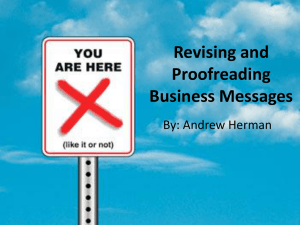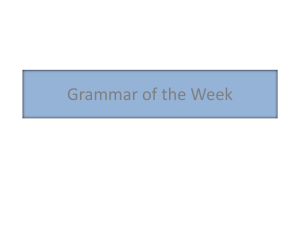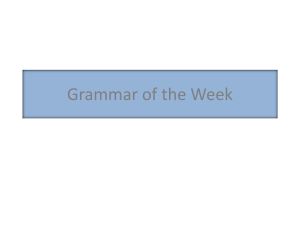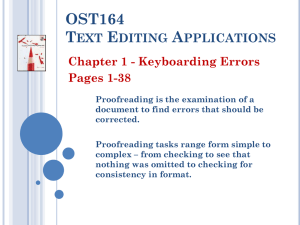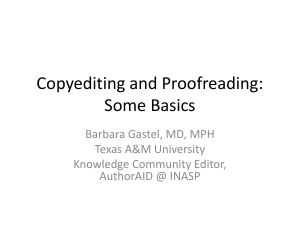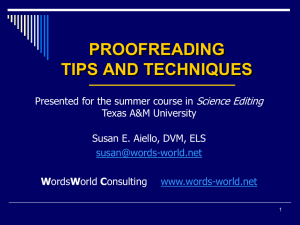Chapter 7: Revising, Proofreading, and Formatting
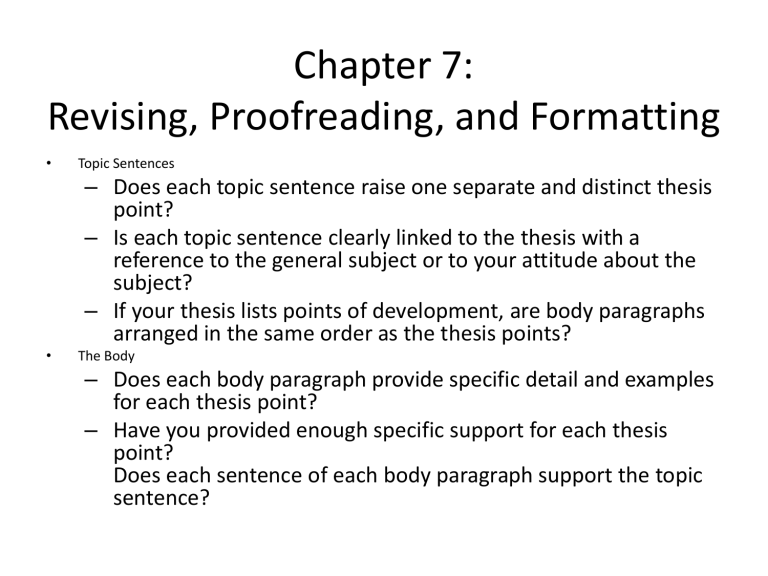
Chapter 7:
Revising, Proofreading, and Formatting
• Topic Sentences
– Does each topic sentence raise one separate and distinct thesis point?
– Is each topic sentence clearly linked to the thesis with a reference to the general subject or to your attitude about the subject?
– If your thesis lists points of development, are body paragraphs arranged in the same order as the thesis points?
• The Body
– Does each body paragraph provide specific detail and examples for each thesis point?
– Have you provided enough specific support for each thesis point?
Does each sentence of each body paragraph support the topic sentence?
Chapter 7:
Revising, Proofreading, and Formatting
• The Conclusion
– Is the first sentence of the conclusion a broad, thesis-level statement?
– Is the conclusion short, with no new information introduced?
– Is the last sentence final-sounding and does it adequately complete the essay?
• Checking Coherence
– In the introduction, is there a clear transition between introductory material and the thesis?
– Have you used transitional words or transitional topic sentences to link the second and third body paragraphs to the rest of the essay?
– Have you used transitions within the paragraph effectively?
Chapter 7:
Revising, Proofreading, and Formatting
Proofreading
• The Top-Down Technique
– The first proofreading should go from the top of the essay down. As you proofread, make sure the connections between ideas are smooth and solid and that the sentences and paragraphs flow smoothly into one another. Check for parallel structure, clear pronoun reference, and appropriate transitional expressions. After correcting errors, move to bottom-up proofreading.
• The Bottom-Up Technique
– This technique is more labor-intensive and more focused than top-down proofreading. When you read from the bottom up, you are no longer reading your essay as a single piece of writing but as disconnected sentences that do not flow into each other.
Chapter 7:
Revising, Proofreading, and Formatting
Proofreading
• The Targeting Technique
– If you have an error that you usually make while writing, check for that error. These are common errors and ways to correct them:
• Subject-verb agreement: Make sure the subject agrees with the verb. A singular subject needs a singular verb, and a plural subject needs a plural verb.
• Comma splices and run-ons: Check long sentences and commas. Make sure that two independent clauses have periods, or are joined with a coordinating conjunction
(FANBOYS = for, and, nor, but, or, yet, so).
• Other comma errors: Check each comma for appropriate placement. To find information on commas, see Chapter 22.
Chapter 7:
Revising, Proofreading, and Formatting
• Pronoun agreement: Check for plural pronouns, such as they and
their. Make sure that they and their refer to a plural antecedent.
• Sentence fragments: Use the bottom-up technique to check if each sentence is correct. Check for the subject and verb to avoid creating fragments.
• Proofreading the Word-Processed Essay
– Spelling and grammar checkers on your computer can be helpful, but they will not eliminate all errors from your writing.
– Read your writing to make sure it is correct.
– The following is an example of correctly spelled words that do not make sense in a sentence:
• Weather or knot ewe use a spelling checker, you knead to proof reed.
Chapter 7:
Revising, Proofreading, and Formatting
Formatting
• The appearance of your writing is quite important.
– Handwritten Documents: Paragraphs and Essays
• Paragraphs and essays should be written on lined 8 ½ x 11-inch paper in blue or black ink. Write on only one side of the paper.
• In the upper right-hand corner of the page, write your name, date, and any other information regarding your class, such as your instructor’s name, class’s title, and the assignment.
• Write the title on the first line of the paper, but do not use quotation marks or underline it. (Quotation marks and underlining are used for published work.)
– Handwritten Documents: Essay Tests
• If you are not required to use a “blue book” or write on the test, use lined paper and write on only one side. Use blue or black ink.
• If you misspell a word or make a mistake, draw a line through it.
Chapter 7:
Revising, Proofreading, and Formatting
• Word-Processed Documents
– Setting Up the Word Processing Software
• Select a font and font size that are easily readable, such as Times
New Roman in 12-point size. Do not use bold or italic font.
• Margins should be one inch all around the document.
• Double spacing should be used.
• The document should be left justified (it should line up on the left side of the page).
– Formatting the Document
• Put your name, date, and any other class information in the upper right corner.
• Center the title. Do not underline or place quotes around the title.
• Indent each paragraph.
Chapter 7:
Revising, Proofreading, and Formatting
• Word-Processed Documents
– Printing and Presenting Your Document
• After the document has been proofread and revised, print it on good quality paper.
• Your instructor may ask you to staple or place a paper clip on the upper left-hand side of the document.
